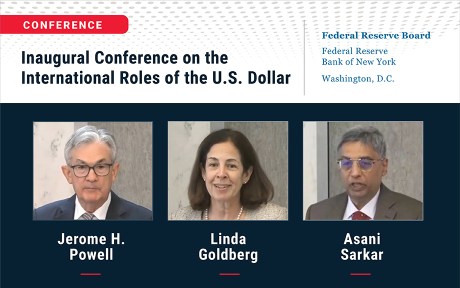
The U.S. dollar plays a central role in the global economy. In addition to being the most widely used currency in foreign exchange transactions, it represents the largest share in official reserves, international debt securities and loans, cross-border payments, and trade invoicing. The ubiquity of the U.S. dollar in global transactions reflects several key factors, including the depth and liquidity of U.S. capital markets, the size of the U.S. economy, the relatively low cost of converting dollars into other currencies, and an enduring confidence in the U.S. legal system and its institutions.
On May 18 and 19, 2023, the Federal Reserve Board and the Federal Reserve Bank of New York jointly hosted the 2nd Annual International Roles of the U.S. Dollar Conference. The aim was to garner the insights of researchers, policymakers, and market experts on the evolving roles of the U.S. dollar, the consequences of these roles for the mandate of the Federal Reserve, and prospects for these roles. Building on insights from the Inaugural Conference held in 2022 (captured in articles in FEDS Notes and Liberty Street Economics), our recent event had a particular focus on themes associated with financial transactions and market conditions. (The event page includes links to the presentation slides and session recordings.)
Benefits and Risks of U.S. Dollar Predominance and the Federal Reserve’s Role
The welcoming remarks by the Federal Reserve Bank of New York’s Markets Group Head Michelle Neal discussed the benefits of the dollar’s roles, including reducing transaction and borrowing costs for U.S. households, businesses, and the government. The dollar offers foreign investors stability in value and access to the liquidity of U.S. financial markets, such as the U.S. Treasury market, which is the deepest and most liquid securities market in the world. Neal underscored the key role that the Federal Reserve plays in supporting the use of dollars internationally through its strong commitment to price stability, which has contributed to confidence in the dollar as a store of value, and the deployment of dollar liquidity backstop facilities, such as the central bank liquidity swap lines and the Foreign and International Monetary Authorities (FIMA) Repo Facility, which have helped improve liquidity conditions in dollar funding markets during recent periods of stress.
In the conference keynote address, Darrell Duffie (Stanford University) provided a sweeping exposition on the global reliance on the dollar, the challenges posed by this financial architecture, and U.S. official-sector policy responses, while also engaging in dialogue with moderator Linda Goldberg (New York Fed). Duffie discussed ways in which the Federal Reserve has supported global dollar liquidity, especially in recent periods. He also emphasized the importance of U.S. Treasuries as a crisis hedge, drawing on his research with Fed coauthors, and proposals to improve market liquidity in high stress periods. Lastly, Duffie dismissed any near-term challenges to broad dollar dominance, but also argued for more proactive approaches by U.S. policymakers to reinforce the dollar’s important global roles.
Barry Eichengreen (U.C. Berkeley) provided an update on the dollar’s status as an official reserve currency, a year after his keynote speech at the Inaugural Conference on the International Roles of the U.S. Dollar. Although there has been a decline in the dollar’s share of global foreign exchange reserves over the last decade, he observed there is limited evidence of changes in reserve composition due to recent financial sanctions. The share of nontraditional reserve currencies has risen from almost nothing at the turn of the century to their current share of about 10 percent, which almost corresponds with the decline in the share of the U.S. dollar. Eichengreen argued that the role of the Chinese renminbi, which accounts for 2.5 percent of reserves, is limited by, among other things, lack of infrastructure, continued capital controls, and China’s governance. Stablecoins and central bank digital currencies have not had large effects, he noted, as the former have proven to be too volatile, while the latter are still restricted to internal country-specific transactions.
Perspectives on the activities and risks faced by global financial institutions engaged in funding markets and in the interconnected network of worldwide dollar flows were provided in a panel moderated by Fabiola Ravazzolo (New York Fed). On the panel were experts from industry, academia, and policy organizations—Fabio Bassi (J.P. Morgan), Rebecca Patterson (Bridgewater), Victoria Ivashina (Harvard Business School), and Beth Anne Wilson (Federal Reserve Board)—who presented diverse and complementary views. Among the points raised were that financial institutions partly meet their clients’ funding needs across currencies by using cross-currency derivatives positions, which, in addition to regulatory requirements, influence the quantity and pricing of their dollar supply. Nonbank financial institutions (NBFIs) were also identified as increasingly relevant in global dollar markets, with a recent growth of private equity investors, mostly domiciled in the United States and with emerging presence in Asia. Of note, panelists discussed that the material dollar-related activities of non-U.S. entities makes the U.S. financial system susceptible to spillovers from foreign shocks, including via dollar funding and asset markets transmission channels. They also highlighted the critical backstop roles played by the Fed’s international dollar liquidity facilities in limiting these spillovers.
Issues of foreign exchange interventions and foreign exchange reserves were discussed in a second panel moderated by Alain Chaboud (Federal Reserve Board) and with expert contributions by Gerardo Garcia (Banco de Mexico), Kerstin Kehrle (Swiss National Bank [SNB]), Jens Nordvig (Exante Data), and Kathryn Dominguez (University of Michigan). Panelists started with a discussion of how foreign exchange interventions have remained an important part of the policymakers’ toolkit around the globe and how the objectives and methods of emerging and advanced economies often differ. The panel then focused on the use of “unsterilized” intervention as a monetary policy instrument, with a particular focus on how the SNB has used foreign exchange intervention to counter both deflationary and inflationary pressure. Panelists also discussed the evolution of foreign exchange intervention by emerging and advanced economies since the global financial crisis and emphasized how closely attuned market participants are to intervention activity. In addition, there was an overview of the evolving academic perspective on foreign exchange intervention and the recent work that incorporates financial and goods market frictions to explain why interventions can be effective and sets out conditions under which it can improve welfare.
New Academic Research Related to the Roles of the U.S. Dollar
Several academic presentations expanded on the themes of the conference. Naoki Yago (University of Cambridge) presented his work, coauthored with Alexander Rodnyansky and Yannick Timmer, on foreign exchange interventions, arguing that unexpected foreign exchange intervention by a number of countries can mute the impact of U.S. monetary surprises on both exchange rates and local stock prices, therefore counteracting the “Global Financial Cycle.”
A study presented by Andreas Schrimpf (Bank for International Settlements), co-authored with Jonas Becker and Maik Schmeling, showed that the demand for foreign banks’ dollar-denominated loans outside the United States can exert pressure on dollar funding markets, which in turn affects the dollar exchange rate. That work also asserts that the relation between foreign dollar lending and the exchange rate has become stronger after the global financial crisis partly due to structural changes in the financial system. Relatedly, David Elliott (Bank of England) presented work with Ralf Meisenzahl and Jose-Luis Peydro exploring how these changes in the financial system, particularly the more prominent role of NBFIs, have affected the global transmission of U.S. monetary policy. The study finds that NBFIs adjust their dollar lending by less than banks when U.S. monetary policy tightens, benefitting emerging market and riskier borrowers.
A series of discussions at the conference explicitly focused on the relationship between international financial flows and institutions and the international roles of the U.S. dollar. Antonio Coppola (Stanford University), in joint work with Arvind Krishnamurthy and Chenzi Xu, provided a new liquidity-based theory for the currency denomination of debt issuance, arguing that liquid stocks of instruments for transaction settlement drive the choice of currency used on debt issuance. Timing mismatches between firms’ receipts of profits and their need to make payment on bonds in particular currencies, and financial technologies that make private assets liquid, support currency choice. Julien Bengui and Nick Sander (both of Bank of Canada) focused on the relationships between currency risk premia and the use of invoicing currencies in international trade transactions. Their idea is that, by country, there is a currency concentration of products in a consumption basket leading to demand for hedging via financial assets and driving down the relative returns on assets in these currencies.
Another set of papers discussed hedging in foreign exchange markets using new data sets. Amy Wang Huber (University of Pennsylvania), in joint work with Wenxin Du, introduced a database of foreign investors’ U.S. dollar security holdings and currency hedging practices created by combing through company filings and industry statistics. Using this new data, they document that foreign investors increased the total amount of U.S. dollar assets by sixfold over the last twenty years and that, even when there is large heterogeneity across countries, sectors, and security types, there is a substantial amount of foreign exchange hedging. Eugenio Cerutti (International Monetary Fund) presented his work with Haonan Zhou, which focused on covered interest parity (CIP) deviations associated with emerging market currencies. These CIP deviations display different dynamics to those in advanced economies and exhibit marked segmentations between onshore and offshore exchange markets. Hilary Stein (Federal Reserve Bank of Boston), in joint work with Vicente García Averell, Gabriel Levin Konigsberg, and Calixto López Castañon, takes a firm-level perspective to understand hedging behavior using data on currency exposure and hedging for Mexican firms. They find that firms make hedging decisions that are consistent with narrow framing; that is, their future hedging decisions are based on the performance of their past decisions.
Concluding Remarks
The Federal Reserve engages deeply on themes around the use of dollars around the world and the frameworks that support deep and liquid currency and funding markets. Dialogue with and lessons from diverse experts provides insights for the stewardship of the dollar and for directions of future policy and institutional developments to fulfill the Federal Reserve’s mission.

Alain Chaboud is a senior economic project manager at the Federal Reserve Board of Governors.

Ricardo Correa is a senior advisor at the Federal Reserve Board of Governors.

Patrick Douglass is a capital markets trading principal in the Federal Reserve Bank of New York’s Markets Group.

Linda S. Goldberg is a financial research advisor for Financial Intermediation Policy Research in the Federal Reserve Bank of New York’s Research and Statistics Group.

Juan M. Londono is a senior economic project manager at the Federal Reserve Board of Governors.

Fabiola Ravazzolo is a policy and market analysis advisor in the Federal Reserve Bank of New York’s Markets Group.
How to cite this post:
Alain Chaboud, Ricardo Correa, Patrick Douglass, Linda S. Goldberg, Juan M. Londono, and Fabiola Ravazzolo, “2nd Annual International Roles of the U.S. Dollar Conference,” Federal Reserve Bank of New York Liberty Street Economics, June 23, 2023, https://libertystreeteconomics.newyorkfed.org/2023/06/2nd-annual-international-roles-of-the-u-s-dollar-conference/.
Disclaimer
The views expressed in this post are those of the author(s) and do not necessarily reflect the position of the Federal Reserve Bank of New York or the Federal Reserve System. Any errors or omissions are the responsibility of the author(s).














 RSS Feed
RSS Feed Follow Liberty Street Economics
Follow Liberty Street Economics